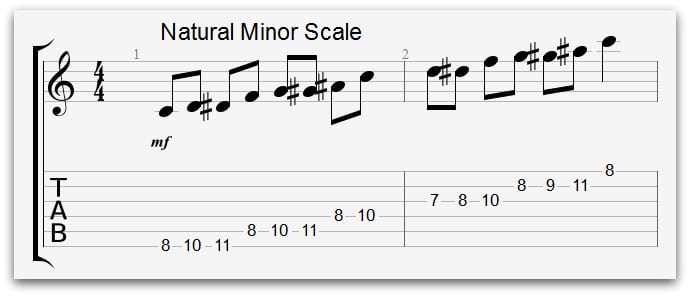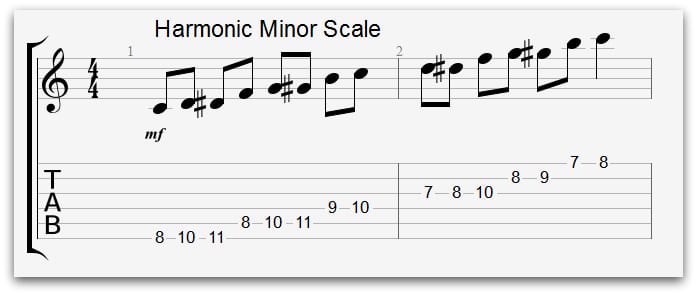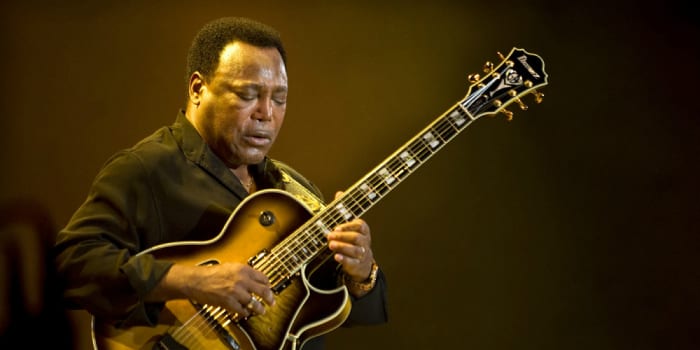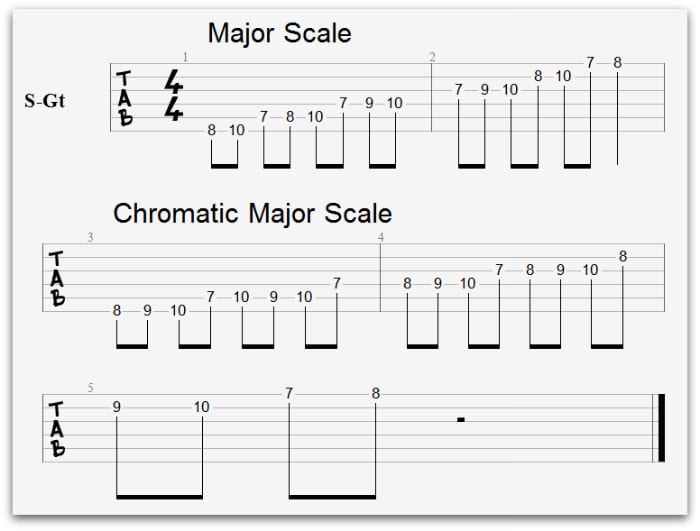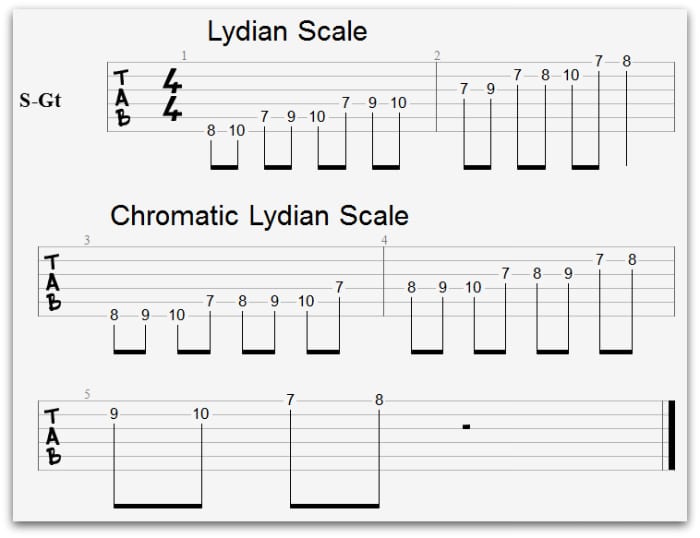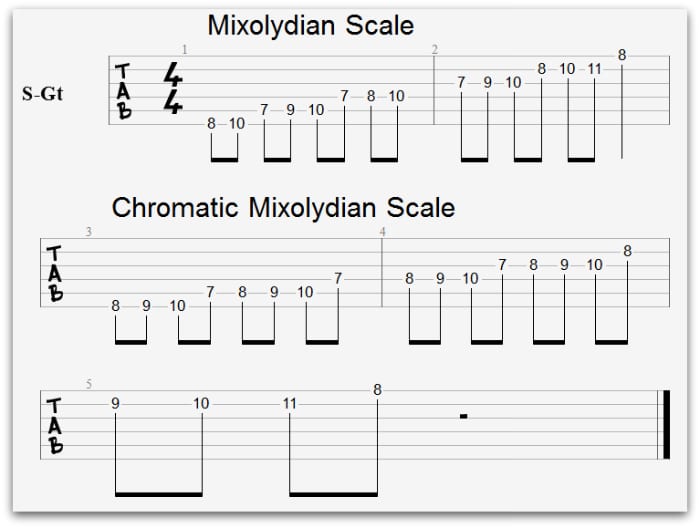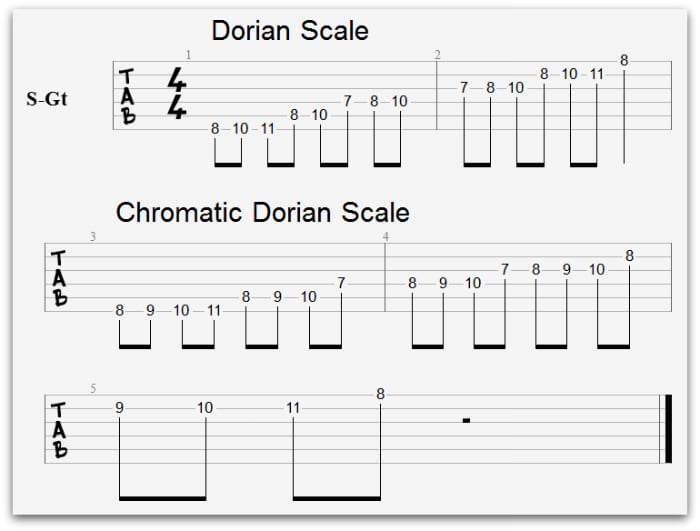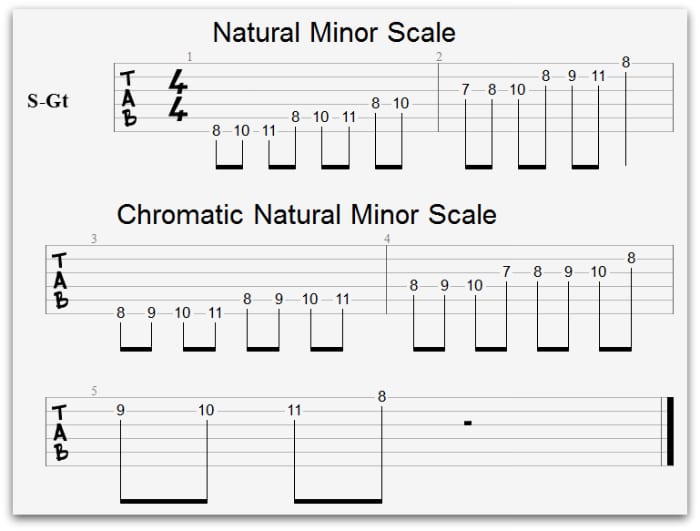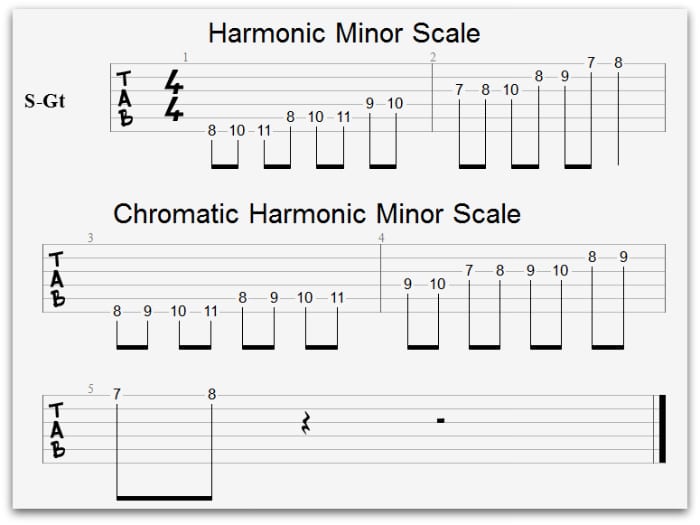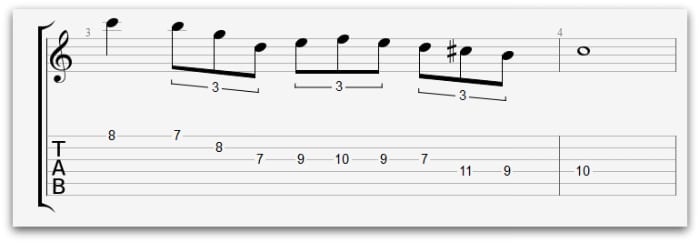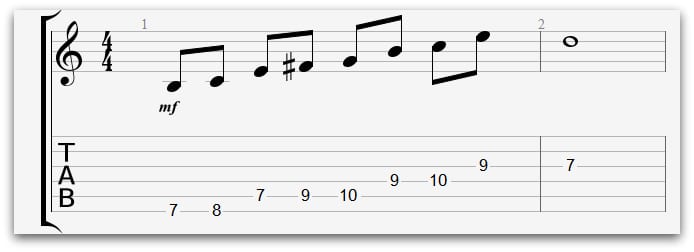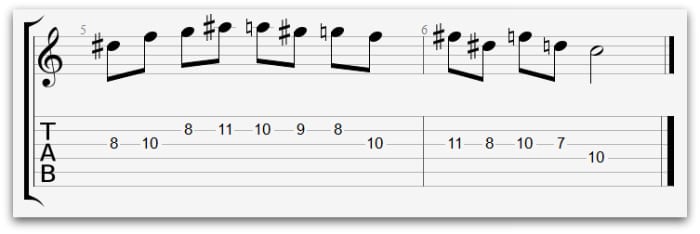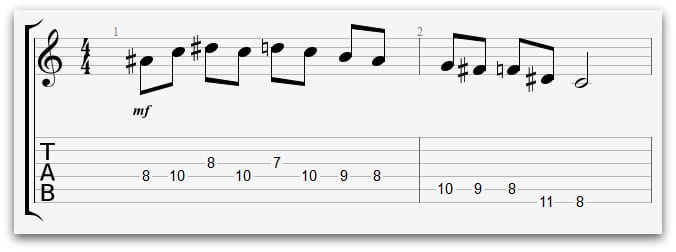Minor Jazz Guitar Scales – The Natural Minor Scale
The natural minor scale also known as the ‘Aeolian Mode’ is one of the most popular minor jazz guitar scales.
This scale is a lot darker sounding compared to the dorian scale.
If you want to achieve mysterious sounds in your jazz guitar solos, you should use this scale.
Here’s the tab and notation:
Here’s what it sounds like:
The natural minor scale is made up of the following intervals:
- Root.
- Major Second.
- Minor Third.
- Perfect Fourth.
- Perfect Fifth.
- Minor Sixth.
- Minor Seventh.
Minor Jazz Guitar Scales – The Harmonic Minor Scale
The harmonic minor scale is must-know for any jazz guitarist, there are some interesting sounds hidden in this scale!
This scale has a spanish flavour. So, if you want to add some extra spice to your guitar solos, use this scale.
Here’s the tab and notation:
The intervals for the harmonic minor scale are:
- Root.
- Major Second.
- Minor Third.
- Perfect Fourth.
- Perfect Fifth.
- Minor Sixth.
- Major Seventh.
Here’s what it sounds like:
Notice how the seventh note of this scale has changed, instead of a flattened 7th. Now we have a major 7th. This is what gives the scale it’s latin flavour.
Want to buy a jazz guitar? Check out this article from Dawsons to find the best jazz guitar: Five Best Jazz Guitars |Dawsons Music
How do I play jazz guitar scales in other keys?
To become an amazing guitarist it’s essential to learn jazz guitar scales in all 12 keys.
To change the key of the scale, you must start the scale on a different fret.
Try this; play a C major scale starting on the 8th fret of the low E string. (6th string.)
Now, move that scale shape to the 10th fret. This now becomes the ‘D major scale’.
Why Does This Work?
When you move your scale shape to a different fret, you are changing the root note of the scale.
The root note of the scale determines what key the scale is in.
All of the scales we have learned so far, start on the low E string. (6th string.)
Therefore, if we want to change the key of the scale, we must know what the root notes are on the low E string. (6th string.) Here they are:
When you move your scale to a different fret, the key of the scale changes.
For example, if you played a ‘dorian scale’ starting on the 2nd fret. It would become a ‘F# Dorian Scale’.
Bonus Challenge
If you fancy an added challenge, try this:
- Play the major scale in every key.
- Play the lydian scale in every key.
- Play the mixolydian scale in every key.
- Play the dorian scale in every key.
- Play the aeolian scale in every key.
- Play the harmonic minor scale in every key.
If you can master this, you will be well on your way to be becoming an amazing jazz guitarist.
Why should I learn jazz guitar scales?
The two main reasons you should learn jazz guitar scales is to:
- Help with your improvisation.
- Help with your guitar theory.
Jazz Improvisation
Jazz music is famous for having a history of fantastic improvisers. Jazz improvisation is impossible to do without any knowledge about jazz guitar scales.
To be able to improvise well, you must learn jazz guitar scales.
Jazz Theory
Learning jazz guitar scales helps your guitar theory.
Guitar theory can be difficult. However, most guitarists enjoy learning guitar scales. The more you learn about jazz guitar scales, the better your theory will be come.
Learning jazz guitar scales is guaranteed to make you a better guitarist.
The secret to enhancing your jazz guitar scales
All of the jazz guitar scales you have learned so far sound great on their own. However, there’s one final touch we can do to help you become a flawless guitarist.
Here’s a quick and easy trick which will help you become a jazz master:
Add chromatic notes in between any two fret gaps within a scale.
Chromatic notes are notes which don’t belong in the scale.
Here’s what you’re going to do:
- Every time there’s a two fret gap in your scale, add a chromatic note in between those two notes.
For example, the first two notes of a C major scale go from the:
- 8th fret to the 10th fret on the low E string to the 10th fret.
To add a chromatic note to this pattern, all you have to do is add in the 9th fret.
Here’s a tab which shows the major scale with its chromatic additions:
The Major Scale:
The Chromatic Major Scale:
You can do this easy jazz trick with EVERY scale. Here’s each of the jazz guitar scales you have learned so far with their chromatic revisions.
Jazz Guitar Scales – The Lydian Scale
The C Lydian Scale:
The Chromatic C Lydian Scale:
Jazz Guitar Scales – The Mixolydian Scale
The Chromatic Mixolydian Scale:
Jazz Guitar Scales – The Dorian Scale
The Dorian Scale:
The Dorian Chromatic Scale:
Jazz Guitar Scales – The Natural Minor Scale
The Natural Minor Scale:
The Natural Minor Chromatic Scale:
Jazz Guitar Scales – The Harmonic Minor Scale
The Harmonic Minor Scale:
The Harmonic Minor Chromatic Scale:
When improvising with these scales, you don’t have to include EVERY chromatic note. Try and explore a few chromatic points within the scale.
Learning Jazz Guitar Licks
One of the best ways to sound like a jazz guitarist quickly, is to learn jazz guitar licks. Learning jazz guitar licks is one of the best ways to speed up your guitar progress.
Learning jazz guitar scales is like learning the words to a language. Words are important to know, but they don’t teach you how to speak a language.
Learning small phrases helps you understand how a language is constructed. Jazz is exactly the same; to sound like a jazz guitarist you must learn jazz guitar licks.
We’re going to show you 6 of our best jazz guitar licks. Hold tight, this is going to be awesome.
1) The Major Scale Lick
This one’s a finger twister. Practice each note slowly.
This lick would work perfectly over anything in the key of C major.
To learn about the key of C major go here: Understanding the chords in the key of C
Here’s the tab:
Here’s what it sounds like:
Once you’re comfortable with playing this lick, try and use it in a musical situation.
2) The Lydian Lick
This lick is perfect if you want to add interest to your major chord progression. Use this lick to create tension within your improvisations.
Here’s the tab:
Here’s how it sounds:
Once you’re happy with how this lick sounds, try and use it in a musical context. It’s important to use these ideas straight away after you’ve learned them.
3) The Mixolydian Lick
If you like soloing over a jazz blues, this lick is perfect for you. Use this quick fire lick over a C blues.
Here’s the tab:
Here’s what it sounds like:
For more blues lessons, go here: Blues Guitar Lessons For Beginners : 4 Ways To Sound Awesome Quickly
4) The Dorian Lick
If you want to bright up your minor guitar solos, you should try and use this awesome guitar lick.
Here’s the tab:
Here’s what it should sound like:
You can practice this lick over a C minor chord progression.
5) The Aeolian Lick
This lick is perfect to add mystery and darkness to your guitar solos. If you want to create tension and suspense, use this guitar lick.
Here’s the tab:
Here’s what it should sound like:
This lick would work great over a C minor vamp.
6) The Harmonic Minor Lick
This lick is FAST. If you can play this lick, you’re guaranteed to turn a few heads at the next jam session!
You can use this lick over anything in the key of C minor.
.Here’s the tab:
Here’s what it should sound like:
Want to learn more about jazz guitar? Go here: Jazz Guitar: A 5-Step Programme For Rapid Jazz Skill
What Type of Guitarist Are You?
Take our 60-second quiz & get your results: Take The Quiz
Join the world's best online guitar school 🌎
- Get your own personalised guitar learning plan (customised just for YOU).
- World-class online guitar courses. Learn at your own pace.
- Community Campus & Learning Forum - A friendly community! Connect with our team & students. 😊
- Beginner Song library with chordsheets, tabs and tips. (Songs suitable for all levels!)
- Regular live streams, seminars and Q&A sessions - Learn from world-class guitar educators. Get all your questions answered!
Click here to learn more about National Guitar Academy membership 
Cool Guitar T-shirts 😎
Look cooler! Check out our merch: Click here to see our merch store
Want free guitar tips and video lessons delivered to your inbox?
Join over 250,000 other guitar learners and subscribe to our guitar-tips-by-email service. (It's free.)
We'll send you a series of lessons that will move you to the next level of your guitar journey.
Learn how everything fits together quickly, easily and effectively. We share ninja tips (for instant fun!) but also timeless fundamentals that will deepen your understanding.

Popular Lessons
How To Learn Guitar: An 11-Step Programme For Beginners
How To Choose The Perfect Beginner Guitar
More Cool Guitar Stuff
Learn about National Guitar Academy: About Us
Visit our YouTube channel for fun guitar videos.
Join us on Facebook for daily guitar tips.
Listen to our Learn Guitar Podcast for rapid guitar progress.
Check out our free chord lessons.
Get our best guitar tips & videos

